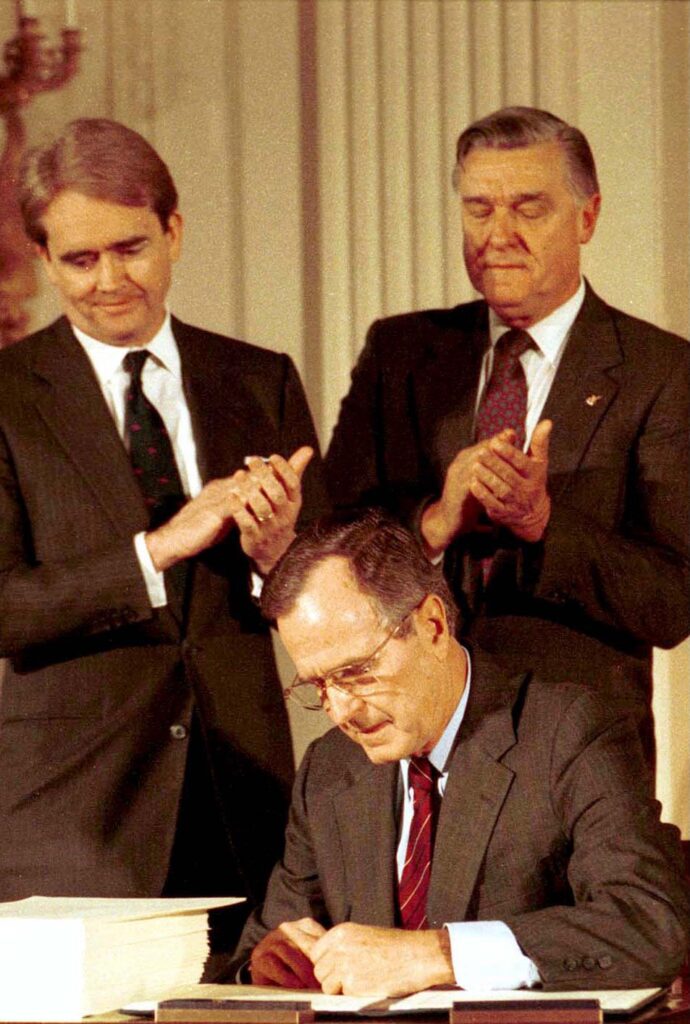
Nearly 35 years after it was signed into law, the Clean Air Act Amendments of 1990 are looked back on as one of the success stories not only of U.S. environmental policy, but of the Administration of President George H.W. Bush. The legislation sought to strengthen the Clean Air Act of 1970 through a series of amendments designed to curb four significant threats to the environment — acid rain, urban smog, toxic air pollution, and the hole in the ozone layer. In each of these areas, the law has had its intended effect.
Since 1990, carbon monoxide pollution is down more than 75 percent, while nitrogen dioxide levels are down by more than half. Particulate pollution levels are down by more than 40 percent. Emissions of toxic chemicals such as benzene and mercury have declined by more than two-thirds, and lead levels in outdoor air have been reduced by more than 99 percent. One of the main causes of acid rain — sulfur dioxide pollution from power plants — has declined by more than 80 percent and is continuing to fall. And, according to NASA, the hole in the ozone layer is getting smaller each year.
The Clean Air Act Amendments of 1990 are looked back on as one of the success stories not only of U.S. environmental policy, but of the Administration of President George H.W. Bush.
What made this law such a success? Political observers will no doubt point to the fact that it was truly a bipartisan piece of legislation, with supermajority support in both Houses of Congress and on both sides of the aisle. Over 90 percent of Democrats and 87 percent of Republicans voted in favor of the plan. To economists, the Clean Air Act Amendments of 1990 were a success for a different reason. Simply put, the law was innovative public policy. President Bush and his economic and environmental advisors understood the importance of harnessing the power of incentives to cost effectively achieve improvements in the nation’s air quality and water quality.
One of the innovations of the Bush Administration was to rely on market mechanisms for reducing the nation’s acid rain problem. In the late 1980s, Midwest coal fired power plants were producing sulfur dioxide emissions and these emissions drifted around the nation causing downwind health problems and exacerbating the acid rain challenge. Rather than requiring a fixed engineering solution for each of these utilities, the market-based approach required the polluter to pay a market clearing price per ton of pollution produced. Under a “cap and trade” system, the government sets the maximum amount of tons of pollution that polluters can emit in total. These tons are then auctioned off to the highest bidder and a market clearing price per ton of emissions is established.
Under these “rules of the game,” each electric utility now had an incentive to seek out cost effective strategies for reducing their emissions. Some might choose to burn cleaner coal or to install scrubbers or to accelerate the closing of an old coal fired power plant and to open up a cleaner natural gas power plant. The choice for how to achieve the pollution goal was left to the decision maker, the firm, who had the most information about the specifics. While some philosophers have argued that it is immoral to create pollution permit markets, free market environmentalists have argued that this approach allows society to achieve a given amount of environmental progress at the lowest possible cost. Intuitively, such a permit system allows those polluters who face a high cost for reducing their emissions to implicitly subcontract with another polluter who has a low cost of reducing emissions. The old “command and control” approach ignored the cost savings that could be achieved by rewarding those with an edge in pollution abatement.
President Bush and his economic and environmental advisors understood the importance of harnessing the power of incentives to cost effectively achieve improvements in the nation’s air quality and water quality.
The market approach to reducing emissions creates strong incentives for dynamic innovation. This learning approach helps to lower the long run costs of achieving a pollution goal and in a global economy helps developing nations to enjoy economic gains with less pollution production as they learn from our innovations. Engineering and applied science have made great progress in recent decades. Young scientists choose what subfield to enter. If the electric utility sector faces a higher price for releasing sulfur dioxide emissions, then it has a much greater incentive to invest in research projects that economize on these emissions. The Bush Administration’s emphasis on the market-based approach to achieving environmental progress rewarded environmental innovation and raised demand for environmental engineers. This has created an incentive for young people to enter the field. In this sense, the market approach to pollution reduction has stimulated experimentation and learning.
Of course, no regulation offers a “free lunch.” Every regulation imposes costs. Some polluting power plants that purchased pollution permits passed on these costs by raising electricity prices. Higher industrial electricity prices did play a role in diminishing the competitiveness of U.S. manufacturing with other nations such as China that continued to rely on cheap coal for power generation.

That said, there is a broad consensus in academic environmental economics that the Bush Administration’s Clean Air Act rules was an effective strategy for mitigating the costs of air pollution.
It was innovative public policy that had the overwhelming support of both political parties. That’s what made it a success, and a model of legislative achievement today.
Matthew E. Kahn is Provost Professor of Economics at the University of Southern California and Visiting Fellow at the Hoover Institution.




